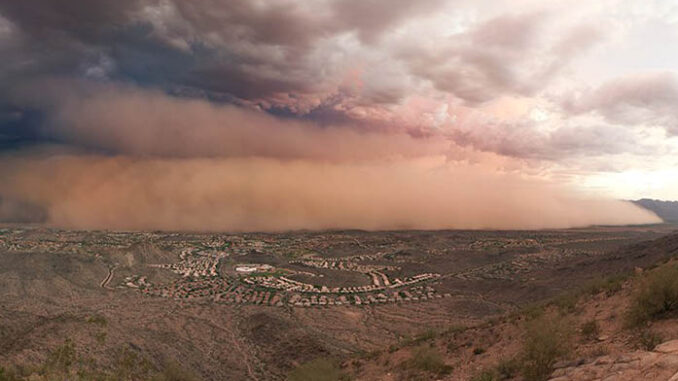
PHOENIX – Monsoon season is here and just as they do every year, officials are warning the public to “Pull Aside, Stay Alive” as the dust storms and torrential rain begin.
According to the Arizona Department of Transportation (ADOT), “Pull Aside, Stay Alive” is the slogan developed to remind drivers who encounter blowing dust, to pull off the road.
ADOT is also providing information about the dust detection system on a stretch of Interstate 10 between Phoenix and Tucson that has been the site of multiple deadly accidents during Monsoon season.
Motorists traveling through this 10-mile stretch of I-10 near Picacho Peak (between mileposts 209-219), an area prone to sudden blowing dust, will see weather radar, overhead message boards and variable speed limit signs:
- As drivers enter the detection zone they will see signs alerting them that they’ve entered a variable speed corridor.
- When the system detects reduced visibility because of dust, variable speed limit signs, which are placed every 1,000 feet near the entrance of the corridor, can change the legal speed limit from 75 mph to as low as 35 mph. Additional variable speed limit signs are placed every 2 miles.
- The system will also automatically activate overhead message boards with a warning for drivers to slow down when visibility drops because of windblown dust.
- If visibility is clear, drivers will notice no change.
ADOT notes that this pilot-project technology exists only in the Picacho Peak area. However, dust storms can occur anywhere in Arizona – and doesn’t replace common sense. When you see a dust storm, do not drive into it. If you get caught in a fast-moving dust channel, follow the “Pull Aside, Stay Alive” tips to help survive a blowing dust event.
- If you encounter a dust storm, immediately check traffic around your vehicle (front, back and to the side) and begin slowing down.
- Do not wait until poor visibility makes it difficult to safely pull off the roadway – do it as soon as possible. Completely exit the highway if you can.
- Do not stop in a travel lane or in the emergency lane. Look for a safe place to pull completely off the paved portion of the roadway.
- Turn off all vehicle lights. You do not want other vehicles, approaching from behind, to use your lights as a guide and possibly crash into your parked vehicle.
- Set your emergency brake and take your foot off the brake.
- Stay in the vehicle with your seat belt buckled and wait for the storm to pass.
- Drivers of high-profile vehicles should be especially aware of changing weather conditions and reduce speeds.
